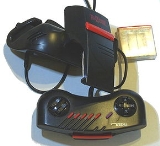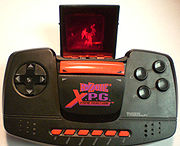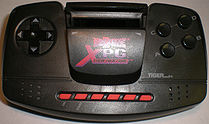
R-Zone
Encyclopedia
The R-Zone was a handheld game console
developed and manufactured by Tiger Electronics
, released in 1995. The R-Zone was a largely unsuccessful handheld console and would only be manufactured for a short period of time. Although the R-Zone was not designed to compete directly with any other handhelds, it marked Tiger Electronics' first multi-game entry into the portable electronic game market.
The original R-Zone unit consisted of a headset and a separate controller containing batteries. Each game cartridge contained its own transparent LCD display screen which was projected onto a mirrored surface held in front of the player's eye. It is thought that this original design, including the red color scheme, was designed to capitalize on popular buzz for the Nintendo Virtual Boy
at the time.


and Game Gear), the R-Zone was often overlooked. Games did not allow users to save their data, link to other gamers, adjust audio levels, play a true variety of games, or connect accessories/peripherals (whereas other handheld consoles in the market did).

Handheld game console
A handheld game console is a lightweight, portable electronic device with a built-in screen, game controls and speakers. Handheld game consoles are run on machines of small size allowing people to carry them and play them at any time or place...
developed and manufactured by Tiger Electronics
Tiger Electronics
Tiger Electronics is an American toy manufacturer, best known for its handheld LCD games, the Furby, and Giga Pets. When Tiger was an independent company, Tiger Electronics Inc., its headquarters were in Vernon Hills, Illinois....
, released in 1995. The R-Zone was a largely unsuccessful handheld console and would only be manufactured for a short period of time. Although the R-Zone was not designed to compete directly with any other handhelds, it marked Tiger Electronics' first multi-game entry into the portable electronic game market.
The original R-Zone unit consisted of a headset and a separate controller containing batteries. Each game cartridge contained its own transparent LCD display screen which was projected onto a mirrored surface held in front of the player's eye. It is thought that this original design, including the red color scheme, was designed to capitalize on popular buzz for the Nintendo Virtual Boy
Virtual Boy
The was a video game console developed and manufactured by Nintendo. It was the first video game console that was supposed to be capable of displaying "true 3D graphics" out of the box. Whereas most video games use monocular cues to achieve the illusion of three dimensions on a two-dimensional...
at the time.
Games

- R-Zone games varied only in title and subject; gameplay within the R-Zone's gaming library was almost identical from title to title.
- Popular franchises released one or more games on the R-Zone: Star Wars, Virtua Fighter, Men in Black, Jurassic Park, Batman, etc.
Controls
The R-Zone's controls are located on the lower top front face of its body and are positioned on the left, right, and bottom sides.- The R-Zone has ten face buttons. The buttons on the right are labeled "A", "B", "C", and "D". The functions of these face buttons vary from game to game but typically the buttons correspond to a four-direction attack scheme (whereas the "C" button would attack to the left, the "D" button would attack up, the "B" button would attack right, and the "A" button would attack down or do nothing at all. The buttons on the bottom are labeled "ON", "START", "SELECT", "SOUND", "PAUSE", and "OFF". The functions of these face buttons are universal and do not vary from game-to-game. The "ON" button simply turned on the console but was largely un-used as inserting a game cartridge would automatically turn the unit on. The "START" button was required to begin all games. The "SOUND" button turned the audio from on-to-off and vice versa. The "PAUSE" button would allow for any game to be stopped at the exact point in which gameplay was taking place. Pressing this button again resumed gameplay. The "OFF" button was used to turn the console off.
- The R-Zone also features a directional padD-padA D-pad is a flat, usually thumb-operated directional control with one button on each point, found on nearly all modern video game console gamepads, game controllers, on the remote control units of some television and DVD players, and smart phones...
, allowing four directions of movement in its games.
Display

- The R-Zone game cartridges were transparent in the center. - This allowed light to pass through and reflect off a specialized mirror to the gamer's eyes.
- The LCD in each cartridge operated identically to Tiger's earlier handheld LCD game units. All of the "graphics" were pre-drawn and permanently set into the LCD itself. Different portions of the display were darkened/activated at different times to provide the illusion of motion or action.
- The mirror had minor tilt adjustment and could be pushed up against the unit for protection and storage.
- The games only displayed a dark red color.
Input/Output
The R-Zone contains the following input/output connectors:- The bottom side of the console shows two ports (one on the left side, the other on the right). Each port was accessible with a screwdriver and held two AAA batteries or two AA batteries. The units manufactured from 1995 to late 1996 held a total of four AA batteries whereas the units manufactured there after utilized a total of four AAA batteries.
- A single speaker allowed for mono audio output.
- An input for R-Zone cartridges is situated on top of the R-Zone.
Sales and Competition
The R-Zone did not see much success in sales. With other successful and popular handhelds (such as the Game BoyGame Boy
The , is an 8-bit handheld video game device developed and manufactured by Nintendo. It was released in Japan on , in North America in , and in Europe on...
and Game Gear), the R-Zone was often overlooked. Games did not allow users to save their data, link to other gamers, adjust audio levels, play a true variety of games, or connect accessories/peripherals (whereas other handheld consoles in the market did).
Variations
A few variations of the R-Zone were produced:
- The R-Zone Headgear (1995) was largely different from later units in that the game cartridge was inserted into a device that was strapped onto the user's head. The user would flip down a transparent lens that was designed to reflect the game images into the user's right eye. The head unit held the game being played and was connected to a controller with a cable approximately 2.5 foot (0.762 m) long. The controller required 4 AAA batteriesAAA batteryA triple A or AAA battery is a standard size of dry cell battery commonly used in portable electronic devices. A carbon-zinc battery in this size is designated by IEC as "R03", by ANSI C18.1 as "24", by old JIS standard as "UM 4", and by other manufacturer and national standard designations that...
, sported a cartridge storage slot (for keeping an additional game protected and available), volume adjustment dial, and brightness adjustment dial. This unit as a whole is sometimes thought to have been designed to compete against the Virtual BoyVirtual BoyThe was a video game console developed and manufactured by Nintendo. It was the first video game console that was supposed to be capable of displaying "true 3D graphics" out of the box. Whereas most video games use monocular cues to achieve the illusion of three dimensions on a two-dimensional...
. The very first game to be distributed with this console was Batman Forever, based on the 1995 movie of the same name, followed by SegaSega, usually styled as SEGA, is a multinational video game software developer and an arcade software and hardware development company headquartered in Ōta, Tokyo, Japan, with various offices around the world...
's arcadeArcade gameAn arcade game is a coin-operated entertainment machine, usually installed in public businesses such as restaurants, bars, and amusement arcades. Most arcade games are video games, pinball machines, electro-mechanical games, redemption games, and merchandisers...
racing gameRacing gameA racing video game is a genre of video games, either in the first-person or third-person perspective, in which the player partakes in a racing competition with any type of land, air, or sea vehicles. They may be based on anything from real-world racing leagues to entirely fantastical settings...
Indy 500Indy 500 (arcade game)Indy 500 is a 1995 arcade racing game by SEGA Japan. It follows the format of previous driving games such as Daytona USA. It includes the famous Indianapolis 500...
.
- The R-Zone Super Screen (1995–1996) allowed R-Zone games to have color for the first time. Some games allowed for a special lens to be used with this particular R-Zone and simply provided the user with a non-animated color background. Game movement on screen was black. The screen was considerably larger than the other R-Zone models, because of this and the fact that the user was not required to look at a mirror (at a precise angle) to see the gameplay, other people could also see gameplay. Because of its size, the R-Zone Super Screen was often not considered a handheld at all. The unit changed the layout yet again and required 4 C batteries to run. In this model the D-padD-padA D-pad is a flat, usually thumb-operated directional control with one button on each point, found on nearly all modern video game console gamepads, game controllers, on the remote control units of some television and DVD players, and smart phones...
was swapped out for four directional buttons (up, down, left, and right).
- "X.P.G. Xtreme Pocket Game" (1997) was a completely handheld version of the console. It lacked a headset, and instead projected the game's display onto a mirrored surface directly above the game controller area on the unit.
External links
- R Zone Head Gear commercial(link goes to commercial on retrojunk.com)
- El Museo de los 8 Bits with a list of games
- miniarcade.com
- Review by Dr. Ashens
- Info and pictures of the R Zone DataZone game console and organizer

